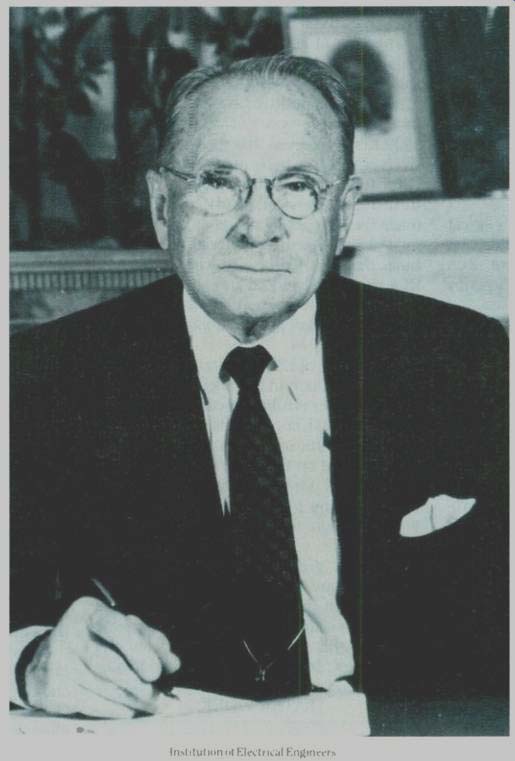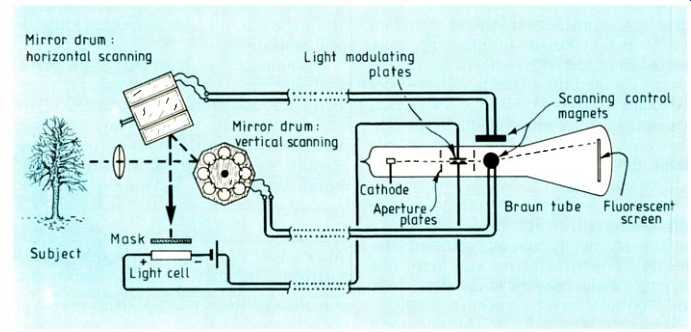10. Vladimir Kosma Zworykin (1889-1982): catalyst of television

by W A. ATHERTON
Bugs scurry in panic when a stone is lifted. Technical historians do a fair impression of the same thing when anyone asks who invented television. Nevertheless, when Vladimir Zworykin died in New York on July 29, 1982, one day short of his 93rd birthday, he was acknowledged internationally as the great pioneer of electronic television.
His obituary in The Times credited his work on television as "the basis for virtually all the later technical advances in the science".
However, Zworykin himself disclaimed the title Father of Television on the grounds that television had many fathers: no single person could be so regarded, he maintained, because a great many inventions had led to modern television.
He was best known for his invention of the iconoscope, the first practical electronic television camera tube. Shortly before that invention he had developed a television picture tube which he called a kinescope.
Together these two developments made good-quality television a reality in the 1930s.
IN RUSSIA
Zworykin spent his formative years in Czarist Russia. He was born on July 30, 1889 in Murom, a small town on the Oka river which lies to the south-east of Moscow. His father was a shipowner who ran a passenger service along the river.
Later he recalled that he was eight years old when he first became aware of electrical engineering, after seeing his father press a button and receive a response from else where in the ship.
After leaving school he entered the Institute of Technology at St Petersburg (now Leningrad) from where he graduated with a degree in electrical engineering in 1912.
Whilst there he was a student of Professor Boris Rosing, probably the first man to achieve television.
It was Rosing who did so much to inspire Zworykin with an interest in electronics and television. Rosing in Russia and A.A. Camp bell Swinton in Britain both foresaw the Institution of Electrical Engineers possibilities of electronic television as early as the first decade of this century, welt before better known names such as Baird.
In 1908, and again in 1911, Campbell Swinton published his ideas for electronic television for which he specified cathode-ray tubes at both the camera and the receiver, both using electromagnetic scanning. The details bear close comparison with Zwory kin's later successful tubes.
Though Campbell Swinton had the right ideas he was unable to transform them into reality. But in Russia, Rosing, with more limited aims, met with some success. At the camera he used the spinning mirror-drum technique to achieve horizontal and vertical scanning together with a photoelectric cell.
The result was displayed on a cold-cathode Braun tube (c.r.t.) using magnetic coils to achieve scanning.
Zworykin recalled that during his time with Rosing (1910-1912) they constructed a cathode-ray picture tube and achieved "stationary geometrical figures, very fuzzy, like a triangle and some kind of distorted circle and so on but with very, very intense light".
Though Rosing did not achieve moving pictures (selenium cells have a slow response time) he did inspire Zworykin. "He started me to dream about television so when I succeeded to reach the United States which was in 1919, I started to look for a place where I could work in television," said Zworykin.
SOMETHING MORE USEFUL
Zworykin's arrival in the USA was not his first foreign travel.
After graduating from St Petersburg he moved to Paris where he did X-ray research at the College de France under Paul Langevin. The outbreak of World War I brought him back to Russia and into the army signal corps.
After the war he travelled around the world and settled in the USA. He became an American citizen in 1924.
With help from Russian friends he gained a position at Westinghouse where, apart from a brief interlude, he stayed until joining RCA in 1929.
In 1923 he applied for his first patent covering a complete electronic television system. This application was amended considerably over the years. Another was filed in 1925 and that covered an essential part of the camera tube, a part which was to be important in the future iconoscope.
In the next two years he actually built an electronic television system using a converted oscillograph tube for the receiver and a specially-made tube for the camera. This, the first electronic television camera tube, is still held by RCA.
A demonstration was given to the Westinghouse management. The date is uncertain but it was probably early in 1925. The stationary picture was poor and Zworykin was advised to work on "something more useful''. Meanwhile the University of Pitts burgh awarded him a doctorate in 1926.
* B. Norman. Here's Looking at You, BBC/Royal Television Society, 1984.
AT RCA
After a tour of Europe in which he visited Germany, Hungary, Belgium, France and Britain. Zworykin moved to RCA in 1929 as director of an electronics research group. By this time several other pioneers had made names for themselves in television.
John Logie Baird had achieved many firsts with mechanically-scanned television including a transatlantic transmission. In America C.F. Jenkins had actually begun what were to be short-lived broadcasts.
Others in France, Germany and the USA were hard at work on television.
When Zworykin returned to the USA in September 1928 he had ideas for a much improved cathode-ray picture tube. Work began almost immediately. Shortly after wards he was able to convince David Sarnoff, the Executive Vice-President of RCA, that a workable television system could be produced in two years. Sarnoff gave the go ahead and the funds.
Sarnoff later called Zworykin a great salesman. "He told me it would cost $100,000 to develop television, but RCA spent $50 million before we ever got a penny back." Zworykin's picture tube was called a kinescope. It had a hard vacuum, an indirectly-heated cathode and a grid for beam current modulation. Electrostatic focusing gave a sharp spot and this has been claimed as the first application of electron optics to a television picture tube. It was the basis of all future tv picture tubes.
This kinescope was announced in November 1929, by which time work was in progress or completed on a radio transmitter and six receivers.
THE STORAGE PRINCIPLE
It was time to return, once again, to the redesign of the camera tube. The first of the new tubes had a double-sided target and 12-line pictures were obtained. It proved the novel principle of temporarily storing the charge generated by the received light. This storage principle, used in the iconoscope and in every television camera tube since, solved the biggest problem of all. Zworykin called it principal contribution to television"*.
Previous workers had scanned the image part by part on to a single photocell. Each picture element was seen by the photocell only momentarily. Consequently little charge was generated per picture element and very, very intense illumination of the subject was needed to produce a usable signal.
Instead Zworykin projected the image on to a mosaic of photocells laid on a sheet of mica. The mica had a conducting plate on the back. Each photocell, insulated from its neighbors, became a capacitor.
Each cell continuously received light from only one part of the subject and so continuously generated and stored charge. A video signal was induced into the conducting plate when the scanning electron beam discharged the capacitors in sequence.
The idea of a mosaic of photocells was crucial. It was not in the original 1923 patent application but was in the 1925 version (as "globules" of photosensitive material) even though storage was not mentioned. The 1929 tubes achieved this mosaic by having rivets pinned into holes in a screen.
In June 1931 Zworykin and his team turned to single-sided insulated targets and made the mosaics by ruling or by evaporating the photosensitive material. It was these tubes that Zworykin called iconoscopes. An RCA chemist developed an easier method of producing the mosaics. After other improvements the iconoscope was announced on 26 June, 1933.
Meanwhile, at EMI in Britain, J.D. McGee and W.F. Tedham independently invented a similar camera tube based on Campbell Swinton's 1911 suggestions. Much to their annoyance some of their patent applications were rejected on the grounds that RCA had already filed for patent protection. (EMI were receiving information about RCA pa tents through a patent exchange agreement.) The EMI group constructed their first tube, contrary to the instructions of their management, in autumn 1932. Zworykin's first single-sided mosaic dates from June 1931 and his globules (mosaic) from the 1925 patent. Zworykin clearly had priority.

Fig. 1. Rosing's television system. Fist transmission was probably on May 9.
1911 when Zworykin was a student under Rosing at St Petersburg.

Fig. 2. Zworykin's iconoscope. announced on June 26, 1933. Its charge-storage
principle, which has been used in every camera tube since, greatly reduced
the lighting level needed to produce a usable picture.
LATER WORK
Zworykin's group continued to improve the iconoscope and it was RCA that produced subsequent tubes: the image iconoscope, the orthicon, the image orthicon and the vidicon.
Zworykin's own interests developed widely. His laboratory produced the first commercial electron microscope for industry (1941). During World War II he directed work on aircraft fire control, tv-guided missiles, a sniper-scope and radar. After the war he worked on high-speed electronic memories and later took a great interest in medical electronics.
Dr Zworykin retired from RCA on 1st August 1954 but it was a nominal retirement. He kept an office there, became Honorary Vice President and also became a director of the Rockefeller Institute Medical Center in New York. As late as 1981 (when he was 90 years old) one writer reported "he still goes to work every morning on his latest project". He continued to read scientific journals and enjoyed swimming every day if the weather permitted.
Amongst the 27 major honors he received were the IEE Faraday Medal (1965) and the American National Medal of Science (1966). In 1959 he was an honored guest in Moscow at the first post-Cold War cultural and scientific exchange between the USA and the USSR. organized by Eisenhower and Krushchev.
He was described as a gregarious individual with a mischievous twinkle in his eyes. Apparently he enjoyed telling jovial anecdotes about himself, including the tale of how on the voyage which took him to America in 1919 he took all his meals alone in his cabin. Dinner jackets were the rule in the dining room and he did not have one.
He held a low opinion of many modern television programs, believing them to have a bad influence on viewers, especially children. His preference was for cultural and educational material rather then "mindless mayhem".
Vladimir Zworykin was survived by Katherine. his wife of 30 years, a daughter and seven grandchildren.
Next in this series of pioneers of electrical communication will be Edwin Armstrong--the man who invented the superhet and made FM radio work.
==========
(adapted from: Wireless World , Oct. 1987)